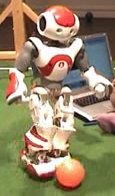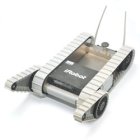Personal robots coming, study finds
Jan 4, 2008 — by Eric Brown — from the LinuxDevices Archive — 1 views The personal robot market will be worth $15 billion annually by 2015, according to an ABI report. Most personal robots shipping today use proprietary OSes, although Linux is slowly migrating from the commercial to the consumer robot market, according to an ABI analyst.
The personal robot market will be worth $15 billion annually by 2015, according to an ABI report. Most personal robots shipping today use proprietary OSes, although Linux is slowly migrating from the commercial to the consumer robot market, according to an ABI analyst.
The ABI study predicts that in the coming years, the personal robot market will continue to be driven by lower prices and improved performance, with an emphasis on single-task robots and relatively simple toybots. Pricing pressure and technical constraints will continue to reward simplicity, said ABI analyst Philip Solis, who reinforced the case for proprietary OSes. “These robots depend on microcontrollers, with very little room to work with, and you need to do a lot with them with a limited amount of processing power,” said Solis. “So the market is still nearly 100 percent proprietary.”
 Aldebaran's Linux-based Nao (Click for details) |
Around 2015, however, ABI expects the market to shift again to higher-priced robots with greater computing power and versatility, at which point Solis sees a growing role for Linux. “Linux and Windows are mostly in the commercial robotics space where you have full PC platforms,” said Solis. “But this will change as the technology gets more standardized and there are more processors used. It still costs about a thousand dollars for the PC part of the robot.”
The study predicts that consumer expectations of robot capabilities will rise. In the long run, consumers may be willing to spend as much on a multi-task humanoid robot as they do on a car, says ABI, replacing multiple single-task robots with fewer, yet more versatile and expensive models.
The embedded Linux community took notice this October when Hanson Robotics revealed a prototype robot toy called Zeno (pictured above left) that uses Linux for its “physical brain” and Windows XP for voice recognition and speech. The 17-inch tall humanoid robot demonstrated abilities to speak, learn, and interact with its surroundings. Hanson predicts the robot will sell for about $300 when it hits the market in a few years.

The Sony Aibo (left) vs. the Linux-based der neue Roboter (right)
(Click for details)
Meanwhile, two of the prototype designs at last July's Robocup — a scientific competition soccer game played by “toy” robots — were based on Linux: Aldebaran Robotics's Nao (pictured above right) and der neue Roboter, (above) — a collaboration between Technical University of Darmstadt (TU Darmstadt), together with Japan's Hajime Research Institute. One of the reasons for moving to Linux cited by the contestants was the fact that Sony's groundbreaking Aibo, which offered one of the most hackable APIs among personal robots, was being discontinued.
 iRobot's Linux-based Packbot Scout (Click for details) |
iRobot is hailed by ABI Research as a model for the industry, thanks to its Roomba vacuum cleaner, a single-task robot said to lead the “task robot” market. iRobot uses Linux in its commercial military robots such as the PackBot Scout (pictured at right), while using its proprietary ROI (robotic operating interface) in consumer robots such as Roomba. ROI's open API leaves the door open to hobbyists wishing to run Linux on the platform, though.
Other consumer robots with proprietary OSes include WowWee's hot-selling Robosapiens, and Ugobe's Pleo robotic dinosaur (pictured below), which ABI pegs as an up and comer.

Ugobe's Pleo
(Click for details)
Availability
ABI Research's “Personal Robotics” study, subtitled “The Market for Task, Security, Entertainment, and Educational Robots and Major Components,” is available at the ABI site. A LinuxDevices review of robotics software for Linux can be found here.
This article was originally published on LinuxDevices.com and has been donated to the open source community by QuinStreet Inc. Please visit LinuxToday.com for up-to-date news and articles about Linux and open source.